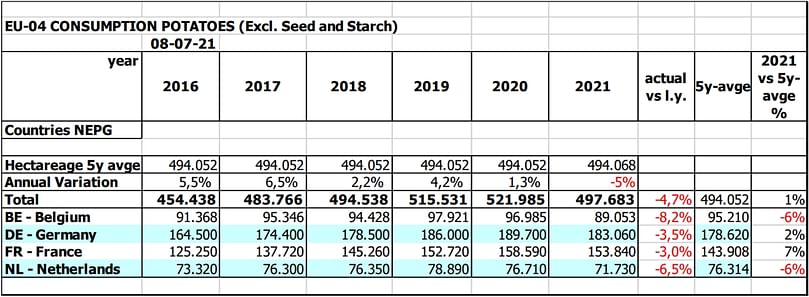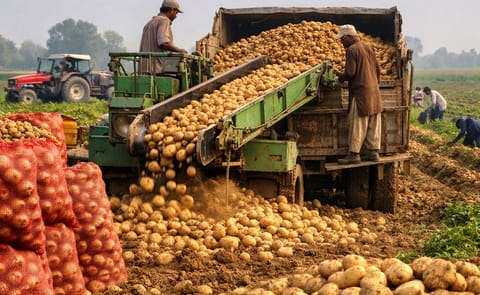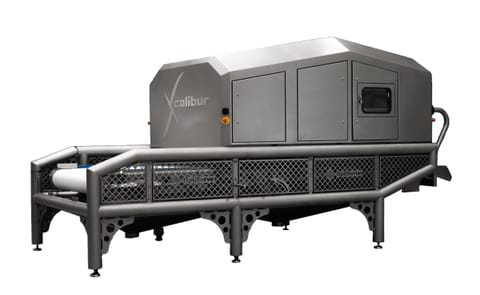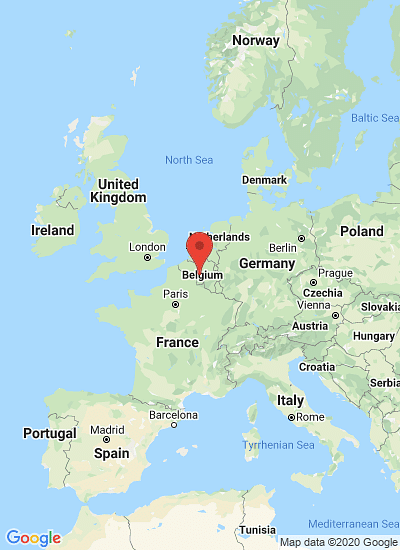The 2021 harvest will depend more on production per ha than lower planted area
Potato harvest North-western Europe will depend more on production per ha than reduction in planted area
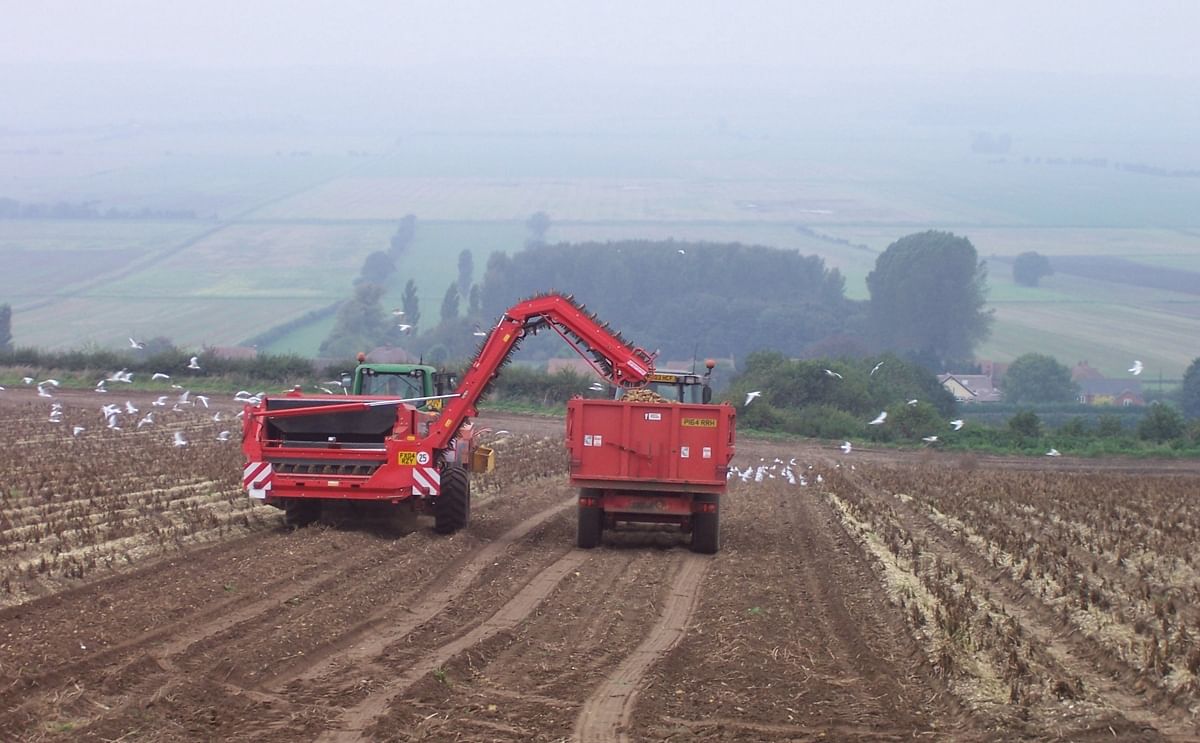
Lower total potato area in EU-04
The total potato area within the NEPG zone (EU-04) has been reduced by 4,7%. Potato area in EU-04 declines from 522.300 ha to 497.700 ha (-24.600 ha). There was a decrease in all countries, but most in Belgium and the Netherlands who had the highest increases in area these last years, are also the only ones with a lower hectarage than the 5 year average (see chart)!
This is an historical event, because area has usually gone up year after year for the last 2 decades… Nonetheless, it is much more the production per ha than the potato area which will make the total 2021 harvest.
Second half of season 2020-2021 marked by some traders buying at higher prices than the Belgapom quotation
In some countries, mainly France and Belgium, growers remark that during the last 3 or 4 months some traders bought at higher prices than the Belgapom Friday quotation to then deliver processors who were not on the market.
Still a lot of unknowns
Be it the earlies or the maincrop, the list of unknowns is still considerable. Concerning the earlies, heavy rainfall the last weeks could impede a rapid enough build-up of dry mater in the tubers. This could lead to some delays in the delivery of contracts. And give some air to the last old potatoes from crop 2020.
In all countries potato plants have developed a lot of leaves, but tubers are much smaller than on average. “A lot of haulm, no tubers” is a remark often heard. Tuberization in maincrop varieties seems higher than what was the case the last 3 or 4 years.
A high tuber count is usually a promise of a potential good harvest, but of course one needs enough water in August and September to fill and fatten all the tubers. Should we get a heat wave and/or a drought, maincrop varieties could be affected much more quickly than was the case the last years, because plants did not make a lot of roots.
The Covid-19 situation, though developing more or less favourably, could still lead to different types of restrictions and thus slow down the demand in frozen chips and other potato products.
Higher production costs and new challenges
Production costs for the 2021-2022 season are already building up: higher costs for blight (and other!) sprays, higher energy prices (diesel and electricity), higher prices for fertilizers (liquid nitrogen saw its price double in a few months). Not to mention everything which has to do with building: insulation material, concrete, steel and wood have also dramatically increased.
Growers are very much aware of new challenges too: more sustainable and robust varieties are needed, be it with more blight resistance, and higher drought and heat tolerances. Varieties which need less fertilizers and are more N-efficient are also needed!
The total potato area within the NEPG zone (EU-04) has been reduced by 4,7%. Potato area in EU-04 declines from 522.300 ha to 497.700 ha (-24.600 ha). There was a decrease in all countries, but most in Belgium and the Netherlands who had the highest increases in area these last years, are also the only ones with a lower hectarage than the 5 year average (see chart)!
This is an historical event, because area has usually gone up year after year for the last 2 decades… Nonetheless, it is much more the production per ha than the potato area which will make the total 2021 harvest.
Second half of season 2020-2021 marked by some traders buying at higher prices than the Belgapom quotation
In some countries, mainly France and Belgium, growers remark that during the last 3 or 4 months some traders bought at higher prices than the Belgapom Friday quotation to then deliver processors who were not on the market.
Still a lot of unknowns
Be it the earlies or the maincrop, the list of unknowns is still considerable. Concerning the earlies, heavy rainfall the last weeks could impede a rapid enough build-up of dry mater in the tubers. This could lead to some delays in the delivery of contracts. And give some air to the last old potatoes from crop 2020.
In all countries potato plants have developed a lot of leaves, but tubers are much smaller than on average. “A lot of haulm, no tubers” is a remark often heard. Tuberization in maincrop varieties seems higher than what was the case the last 3 or 4 years.
A high tuber count is usually a promise of a potential good harvest, but of course one needs enough water in August and September to fill and fatten all the tubers. Should we get a heat wave and/or a drought, maincrop varieties could be affected much more quickly than was the case the last years, because plants did not make a lot of roots.
The Covid-19 situation, though developing more or less favourably, could still lead to different types of restrictions and thus slow down the demand in frozen chips and other potato products.
Higher production costs and new challenges
Production costs for the 2021-2022 season are already building up: higher costs for blight (and other!) sprays, higher energy prices (diesel and electricity), higher prices for fertilizers (liquid nitrogen saw its price double in a few months). Not to mention everything which has to do with building: insulation material, concrete, steel and wood have also dramatically increased.
Growers are very much aware of new challenges too: more sustainable and robust varieties are needed, be it with more blight resistance, and higher drought and heat tolerances. Varieties which need less fertilizers and are more N-efficient are also needed!
Like to receive news like this by email? Join and Subscribe!
Get the latest potato industry news straight to your WhatsApp. Join the PotatoPro WhatsApp Community!
Highlighted Company
Sponsored Content
Sponsored Content
Sponsored Content
Sponsored Content

